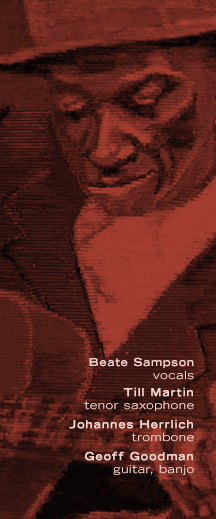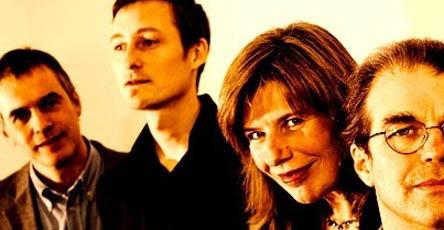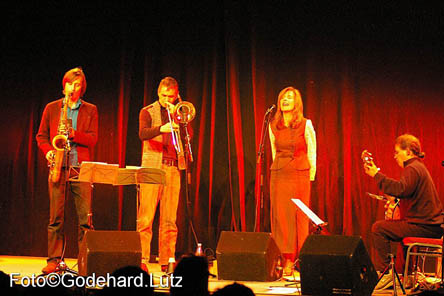|
ROSEBUD PLAYS THE MUSIC OF NEWPORT Auf diesem von Pete Seeger initiierten Festival stellte sich ab 1959 die amerikanische Folkszene in ihrer großen Stilvielfalt dar: von der "traditional Appalachian mountain music", über Bluegrass, Blues und Gospel bis hin zu den Protestsongs von Bob Dylan. Neben jungen Stars der Szene wie Peter, Paul & Mary, Buffy Saint Marie, Joan Baez und Donovan traten auch legendäre, alte Bluesmusiker auf: Mississippi John Hurt, Skip James, Son House und Elisabeth Cotten zum Beispiel. In eigenen und überlieferten Liedern erzählten sie von Liebe und Tod, Mord und Geistern, von der Bewältigung des Alltäglichen und gesellschaftlichen Ungerechtigkeiten, vom herbeigewünschten "social change" und vom Glauben an Gott. Die archaische Poesie und naive Kraft dieser Songs erschließt uns das Rosebud in eigenständigen Interpretationen. Durch Re-Harmonisierungen, rhythmische Finessen und Improvisationen entwickelt das ungewöhnlich besetzte Ensemble dabei eine neue, den Jazz induzierende Klangebene für die Originale.
Die Essenz der Songs bleibt dabei erhalten, und ihre Wurzeln werden nicht gekappt. Das liegt an der ebenso sensiblen wie zupackenden Musikalität des Trios und am Gesang von Beate Sampson, die als erfahrene Jazzinterpretin mit der Seele einer Folksängerin den leidenschaftlichen, aber auch oft lakonischen Tonfall der musikalischen Gleichnisse, Moritaten und Erzählungen bis in die feinsten Nuancen trifft.
Rosebud Plays the Music of the Newport Folk Festival is an ingenious reworking of songs from the American folk and blues traditions, a harmonic, melodic, improvised remoulding of those traditions into a more modern mythos. The songs are often violent and tragic, relying heavily on straight-forward lyrics chronicling the bitter-sweet life experiences of the generations of European immigrants and former slaves who have worked out their destinies in the coal mines, farms, and small towns ranging from Appalachia, through the Mississippi Delta, the Ozarks, the Texas Panhandle, and beyond. Rosebud plays out folk tales that include the rape and murder of a young innocent, a mother's grief for her three dead children, and a man's sense of desolation on learning of his lover's death; but there is also a tender lullaby, a song of a child yearning for the escape and adventure of destinations unknown, and the stream-of-consciousness monologue of a banjo-playing drifter. Folk is the music's heartbeat; diversity and innovation is Rosebud's lifeblood. Solos and duos and trios in every combination; dynamics ranging from delicate simplicity to muscular polyphony - Rosebud has somehow found a way to create an incredibly expansive sound out of two horns, voice, and guitar or banjo. The genius of this music is that it shines a new light on the folk tradition, augmenting and at times transforming it. Perhaps more to the point; Rosebud Plays the Music of Newport is simply a joy to listen to.
NEWPORT FOLK FESTIVAL 1960-65 The Newport Folk Festival was founded 1959 by a small group of people including Pete Seeger and George Wein (founder of the already well established Newport Jazz Festival) .The first years were crucial in moulding its concept and ideology. Folk was a blossoming form in those days - the festival encompassed many aspects of "folk music"- bluegrass, gospel and spiritual, ethnic singers and dancers. Newport became famous for introducing new artists, many of whose careers catapulted out of those festival days, and eventually sky-rocketed into international acclaim. Joan Baez, Peter, Paul and Mary and especially Bob Dylan, who first appeared in 1963, were all artists who became associated with Newport. Another important aspect associated with the festival was the 1960s Blues Revival; many legendary artists who had disappeared into obscurity in the1940s were rediscovered through their appearances at Newport. These artists included Mississippi John Hurt, Skip James, Elizabeth Cotten, Son House and many others, who from the early 60s on became Festival regulars. By 1965 folk music's audience become a marketable commodity; the music enjoyed growing popularity on television, in the press and even on Top Ten radio. Correspondingly, as the artists became more celebrated, the festival grew in attendance. Bob Dylan had become an icon for the folk music world and Newport. In July 1965 Dylan, accompanied by members of the Paul Butterfield Blues Band, walked on stage for his highlighted Sunday night appearance, and proceeded to shock and rock the folk world by going electric. The audience's, as well as his artistic peers' hostile reaction (Pete Seeger wanted to pull the plug), marked a shift in Dylan's direction from folk to rock. This would have a major influence on folk music's future styles and direction. |



